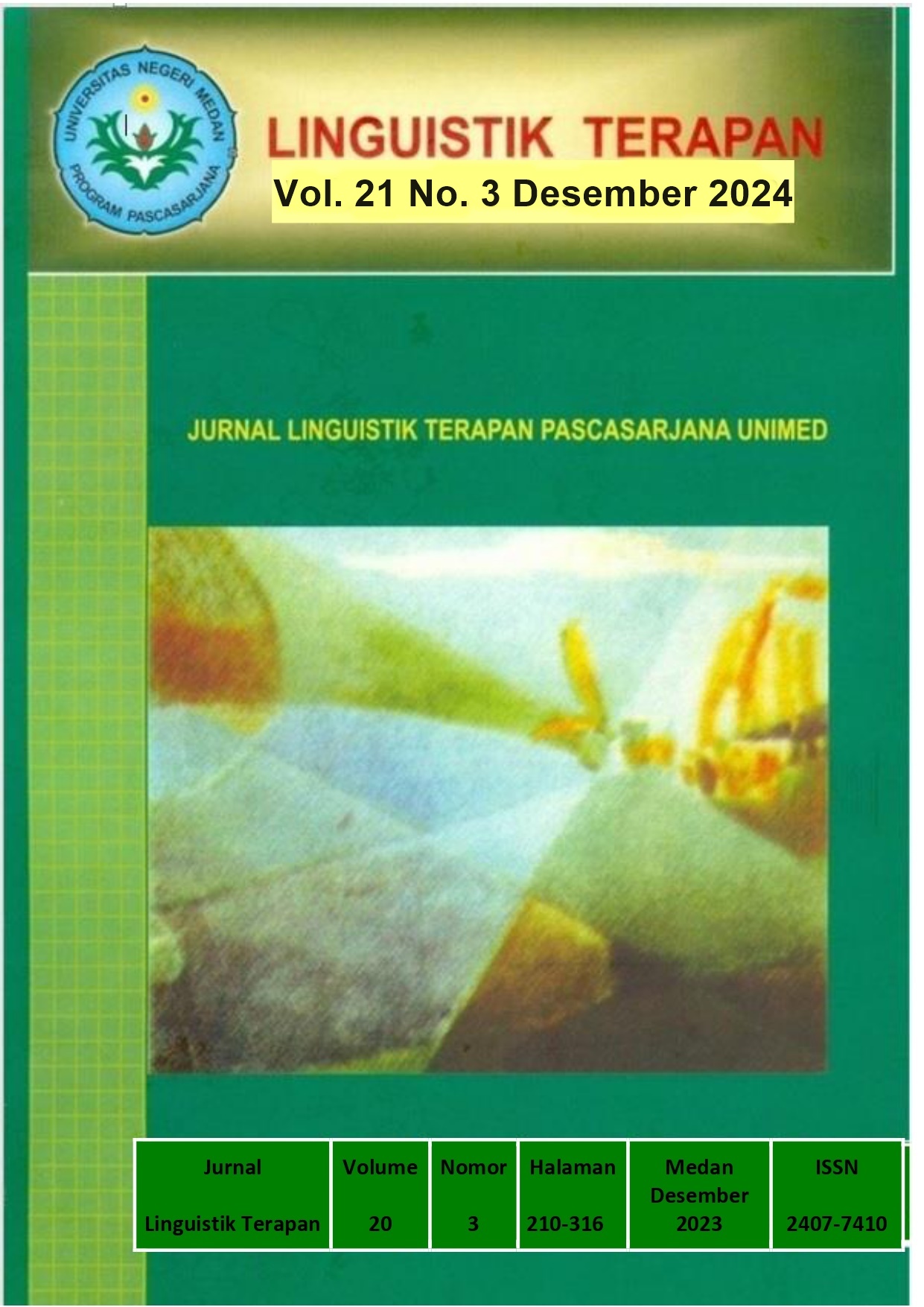Food Blog Found on Love and Lemons Blogger: Corpus Analysis of Culinary Linguistics
DOI:
https://doi.org/10.24114/lt.v21i3.64895Keywords:
Food Blog, Corpus Analysis, Culinary LinguisticAbstract
This study aims to determine the lexical items, food blogs, and hedges found on Love and Lemons bloggers using the AntConc corpus application based on Crystal and Diemer & Frobenius' theory. This research method uses mixed-method qualitative and quantitative data. The data source for this research was taken from the two most viewed recipes from the Love and Lemons blog entitled breakfast sandwiches and healthy breakfast tacos. This study focuses on the frequency of occurrence of lexical items, hedges and the use of food jargon found in recipes for breakfast sandwiches and breakfast healthy tacos. The results of this study indicate that lexical items found in Breakfast Sandwich (106), modification breakfast sandwich (13), evaluation breakfast sandwich (12) and hedges breakfast sandwich (7). While the classifications of lexical items found in recipe Breakfast Healthy Tacos (47), modification breakfast healthy tacos (13), evaluation breakfast healthy tacos (12), Hedges Breakfast Healthy Tacos (6). Based on the results the lexical contained in the Love and Lemons blog is widely used in the process of making healthy breakfast sandwiches and breakfast tacos. Based on Crystal theory found (8) types of food and (9) connotes of food from recipe breakfast sandwich and (12) types of food, (8) connotes of food from recipe breakfast healthy tacos. Food jargon terms are often used in food processing and food recipes in breakfast sandwich recipes and healthy breakfast taco recipes. Use hedging on the Love and Lemons blog to express a lack of certainty or caution in presenting readers with additional choices or options about which recipe to mix.References
Anderson EN (2014). Everyone Eats: Understanding Food and Culture. New York. New York University Press.
Annuk Eve (2013). Culinary Discourse: Organic Food in Estonia, in Liisi Laineste. In Dorota Brzozowska and Wladyslaw Chlopicki (eds) Estonia and Poland: Creativity and Tradition in Cultural Communication, Tartu: ELM Scholarly Press. 2: 137-146.
Anthony F. Buccini (2012). On The Relationship Between Fasting and Feasting. Oxford Symposium on Food and Cookery. Beat Siebenhaar (2006). Code choice and code-switching in Swiss-German Internet Relay Chat rooms. Journal of Sociolinguistics 10/4, 2006: 481–506.
Cesiri, Daniela. (2015). Variation in English across Time, Space and Discourse. An Introductory Textbook. Roma: Carocci Chu-Ren Huang and Yao Yao (2015). Corpus Linguistics. 2015 Elsevier Ltd. International Encyclopedia of the Social & Behavioral Sciences, 2nd edition, Volume 4.
Cornelious Puschmann (2009). Diary or Megaphone? The Pragmatic Mode of Weblogs. Heinrich-Heine University Düsseldorf Benzenbergstrasse 39 40219 Düsseldorf, Germany.
Crystal, David (1996). The Cambridge Encyclopedia of the English Language. Cambridge: Cambridge University Press. Diemer & Frobenius, Stefan, and Maximiliane Frobenius (2013). “When Making Pie, All Ingredients Must Be Chilled.
Including You. Lexical, Syntactic and interactive Features in Online Discourse – A Synchronic Study of Food Blogs.” In Culinary Linguistics. The chef’s special, edited by Cornelia Gerhardt et al., 53–81. Amsterdam: Benjamins.
Dohra Fitrisia, Robert Sibarani, Mulyadi, Mara Untung Ritonga (2018). Traditional food in the perspective of culinary linguistics. International Journal of Multidisciplinary Research and Development. Volume 5; Issue 2; February 2018; Page No. 24-27
Ervi Virna (2007). Wisata Kuliner. Warta Pariwisata. Maret; 9(1):1-4.
Gerhardt, Cornelia (2013). “Food and Language – Language and Food.” In Culinary Linguistics. The chef’s special, edited by Cornelia Gerhardt et al., 3–49. Amsterdam: Benjamins
Jabonillo JP (2016). A Preliminary Research on Boholano Culinary Linguistics. (Thesis) Department of Linguistics, University of the Philippines.
Jennifer Lofgren (2013). Food Blogging and Food-related Media Convergence. Convergence. M/C Journal, 16(3).
John W. Creswell 1999. Mixed-Method Research: Introduction and Application. Copyright © 1999 Elsevier Inc. All rights reserved.
Kerstin McGaughey (2010). Food in Binary: Identity and Interaction in Two German Food Blogs. 2010 by The University of California. Cultural Analysis 9 (2010): 69-98
Maengkom David (2015). Antara Gastronomi dan Kuliner. Indogastronomi. https://indogastronomi. wordpress.com/2015/11/07/kuliner/.
Soegiarto D (2008). Pengaruh Perilaku Wisatawan Nusantara terhadap Wisata Kuliner di Surakarta. Jurnal Pariwisata Indonesia JPI. 2008; 14(1):569-576.
Soenardi (2013). Teori Dasa rKuliner: Teori Dasar Memasak untuk Siswa, Peminat, dan Calon Profesional. Jakarta. PT Gramedia Pustaka Utama.
Swales, John M. (2011). “The Concept of Discourse Community.” In Writing about Writing. A College Reader, edited by Elizabeth Wardle and Doug Downs, 466–473. Boston: Bedford-St. Martin’s.
Tony McEnery, Andrew Hardie (2011). Corpus Linguistics: Method, Theory and Practice. Cambridge University Press.
Thorne, S. L., & Reinhardt, J. (2008). "Bridging activities," new media literacies, and advanced foreign language proficiency. CALICO Journal, 25(3), 558-572.
Warschauer, M., & Kern, R. (2000). Network-based language teaching: Concepts and practice. Cambridge University Press.
Downloads
Published
How to Cite
Issue
Section
License
Copyright (c) 2025 Muhammad Givahri Aldiansyah, Winda Setia Sari

This work is licensed under a Creative Commons Attribution-ShareAlike 4.0 International License.






